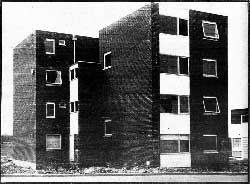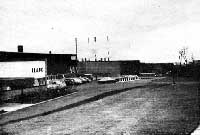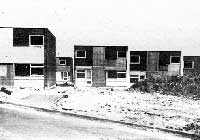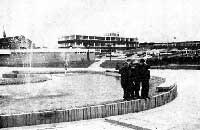
 |
Online
Archive
|
| Issue 5 - May 1972 |
| Peterlee - City Of Trees |
 Peterlee is one of England's 18 new towns, and the first to be started in the north. The project was started in 1948 with two objectives - to provide new jobs in the region to replace those lost in pit closures, and to rehouse families away from the pit villages of Easington Rural District. The site chosen was centrally placed between Hartlepool, Durham and Sunderland, and more specifically near Horden - one of the few long-life pits in the district - which could supply materials for new industry.
After the powers that be had decided to build a new town, people had to be moved to it. So, as houses deteriorated in the neighbouring villages, families were 'offered' new accommodation in Peterlee. They had no choice in the matter, so that a good proportion of the town's population is there against its will. Again, no thought was given to the people involved in the situation, or to community ties and social structures. Planning "The planning of Peterlee reveals the shape
of a town where the motor car can be subordinated to human use
and need and where
an environment to live in has been created which can bear comparison
with any other developments that have taken place." "The planning of Peterlee reveals the shape
of a town where the motor car can be subordinated to human use
and need and where
an environment to live in has been created which can bear comparison
with any other developments that have taken place."
Dan Smith (one-time NEDC chairman, PRO man extraordinaire, and past chairman of the Peterlee Development Corporation) in the Corporation's 1969 report. If Dan Smith says Peterlee was planned, then I suppose it was, but no-one in the town itself seems to think so. They see it as a completely haphazard development, with its own insane logic. For example, in 1968 the Corporation decided that a bus station was needed in the town centre, but when it was half-built they changed their mind (sic) and the uncompleted shell now serves as a car park. Also, after the town centre was built, it was decided that a new town needed a pedestrian shopping centre, so a precinct was built on two levels on the site of the former main street, and thousands of pounds had to be spent on re-routing the traffic.
But then it must be difficult to plan a town that's being built on a coal field - all the time there is a running battle between the NCB and the Development Corporation about whether what's going on above ground or below is more important - generally bits of the town are built where the NCB decides not to mine. Even so, there's been trouble with subsidence, and it's ironic that the Development Corporation office has sunk ten feet in the last eight years. Another nice touch is that the original architect was a man called Lubinski: world famous for building a multi-storey block of flats outside London and the extension to London Zoo!! Industry The aim of Peterlee was to provide a new industrial base for the
people of the north-east to stop them from moving south when the
mines closed. This it has always failed to do. The NCB is still the
largest employer in Peterlee (after the dole). Industrial estates
have quickly become exploitation factories; the whole set-up has
been something of a con trick. The factories employ only the cheapest
labour (women) in light industries. The aim of Peterlee was to provide a new industrial base for the
people of the north-east to stop them from moving south when the
mines closed. This it has always failed to do. The NCB is still the
largest employer in Peterlee (after the dole). Industrial estates
have quickly become exploitation factories; the whole set-up has
been something of a con trick. The factories employ only the cheapest
labour (women) in light industries.
As of March 1971 (the latest figures available) the population of Peterlee was 24,548 and only 1,380 men and 2,252 women had jobs. Unemployment even then was 7.2% - the highest figure for any new town. The Corporation itself, although professing to be concerned at the situation (although businessmen are never really worried by such a state of affairs) hardly helped by deciding to make Peterlee the science centre of the north. In encouraging technologically advanced industry - presumably for prestige reasons - they seemed to want to discourage industries employing large numbers of unskilled and semi-skilled men. Instead huge amounts were spent on large sites employing very few people. IBM spent £0.25 million on a vast computer complex right in the centre of Peterlee employing a mere handful of men. Although the Development Corporation estimate that the town should be responsible for 12,000 jobs by 1980, this seems hardly likely.
 "The only brief that was given to the design
team was to produce an architecture which could give expression
to the needs of an expanding
community and by the aesthetic and organic use of space encourage
social participation." "The only brief that was given to the design
team was to produce an architecture which could give expression
to the needs of an expanding
community and by the aesthetic and organic use of space encourage
social participation."
So says the blurb, and in accordance with this policy an artist was appointed in 1954 to work with the architects. The result is now becoming apparent - a town that is unliveable in. Because of all the concrete, and the site of the town itself, it is far too hot in summer and freezing cold in winter. In fact, although housing was the Corporation's
stated first priority, it has been the area of bitterest complaint
on the part of the residents,
and greatest inefficiency on the part of the Corporation. There has
been constant trouble; because of the coalfield, and because Peterlee
was built on a geological fault, there has been considerable subsidence.
Other houses have been substandard, and nearly all have been shoddily
built. In February 1970 the Corporation even went so far as to refuse
to accept 533 houses because they were substandard. However it is
mainly about the older houses that there are most complaints. There
seems to be general agreement in the town that the Corporation is
not the slightest bit bothered with the older areas of the town.
It is supposed to be  "One of the directives given to the Corporation
in 1948 was that Peterlee should provide, for the first time, a
commercial and
social centre for the main part of the Easington Rural District as
well as the new town." "One of the directives given to the Corporation
in 1948 was that Peterlee should provide, for the first time, a
commercial and
social centre for the main part of the Easington Rural District as
well as the new town."
It's difficult to see how the Corporation can consider that it has in any way achieved this objective. Having forcibly destroyed the carefully built-up community sense of the original pit villages, having moved people wholesale up to the bare heights of Peterlee, the Corporation has made no attempt to provide any social amenities for the new town at all. Houses don't make a town, but none of the experts concerned with building Peterlee seemed to have realised this simple fact. One of the strongest voiced complaints is that
there is nowhere for the kids to play. The only place for them
to go in the centre
of town is the Arts and Information Centre, and although they don't
cause any trouble, they are kicked out by the PDC 'police', who seem
to rule the town with a rod of iron. A PDC patrolman told me "We
don't have much trouble here". Not surprising really - they
have dog patrols in the city centre at night to keep out undesirable
characters. "We break up gangs immediately they form" I
was told. Can you Ian |